JMS-T2000GC AccuTOF™ GC-Alpha High Performance Gas Chromatograph - Time-of-Flight Mass Spectrometer Model:JMS-T2000GC AccuTOF GC-Alpha
Alpha – The New Beginning
The Alpha takes you to a new world of mass spectrometry.
Introducing JMS-T2000GC "AccuTOF™ GC-Alpha", the ultimate GC-MS with superior performance and ease of operation.
Introducing JMS-T2000GC "AccuTOF™ GC-Alpha", the ultimate GC-MS with superior performance and ease of operation.

-
∎ Key Technology 1
The JMS-T2000GC AccuTOF™ GC-Alpha is the 6th generation JEOL GC-TOFMS and has an improved ion optics system to achieve ultra-high resolution.
The AccuTOF™ GC-Alpha is an orthogonal-acceleration time-of-flight mass spectrometer(oaTOFMS) with dual stage reflectron. It employs an ideal ion optical system realizing both high ion transmission(=sensitivity) and ultra-high resolution.
Mass resolution and mass accuracy – Crucial for qualitative analysis

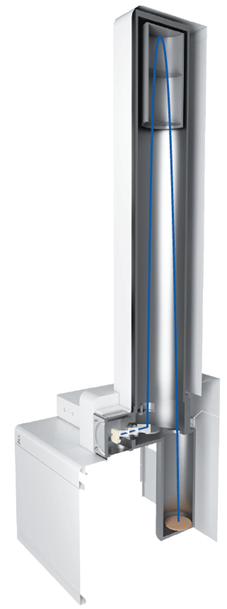
The Resolving power of a time-of-flight mass spectrometer is calculated according to the formula above. With this equation in mind, the new JMS-T2000GC AccuTOF™ GC-Alpha hardware was designed to achieve ultra-high resolution using the following principles:- Make t longer: increase the flight distance 4 m
- Make Δ t smaller: new ion optical system using dual stage reflectron
- Make Δ t smaller: ion transfer system that can accommodate ions with a wide range of kinetic energy
With the newly developed hardware, the AccuTOF™ GC-Alpha features 6 times higher resolution than the first generation AccuTOF™ GC and has a mass accuracy of ≤ 1 ppm.
Acquiring unrivaled high-quality data, the AccuTOF™ GC-Alpha is the ultimate solution for GC-MS qualitative analysis.
Basic Performance of AccuTOF™ GC-AlphaHigh performance for both qualitative and quantitative analysis
Four “High” specifications and two “Wide” specifications achieved simultaneously
The JMS-T2000GC AccuTOF™ GC-Alpha is a high-performance GC-MS system that simultaneously realizes high mass resolution, high mass accuracy, high sensitivity, high speed data acquisition, wide dynamic range, and wide mass range.
The high mass resolution and high mass accuracy offers unprecedented qualitative analysis results. The high-speed data acquisition can be used for advanced GC-MS measurements such as comprehensive two-dimensional GC (GCxGC), while the wide dynamic range is useful for not only quantitative analysis but also for qualitative analysis of complex mixtures. The wide mass range is especially useful for direct MS measurements, and high sensitivity enables unprecedented information about trace components.
The AccuTOF™ GC-Alpha is truly a high-performance GC-MS system that removes the limitations for chemical analysis.High Sensitivity
The standard EI ion source with ultra-high sensitivity is capable of trace quantitative analysis.
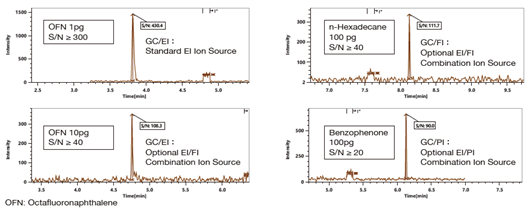
Instrument Detection Limit: IDL=18.7 fg
Eight sequential measurements of 100 fg of octafluoronaphthalene (OFN) were obtained by using the standard EI ion source.
The instrument detection limit (IDL) is calculated based on the peak area and reproducibility of the extracted ion chromatogram for the molecular ion. An IDL of 18.7 fg was achieved for the system.
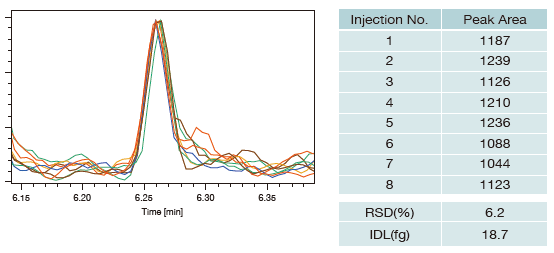
Wide Dynamic Range: 4 orders
OFN at concentrations ranging from 0.1 to 1,000 pg/uL (4 orders) were measured using the standard EI ion source and a high degree of linearity was confirmed. The wide dynamic range is useful not only for quantitative analysis but also for qualitative analysis of complex mixtures with different concentrations.

High Speed Data Acquisition: 50 Hz
For GCxGC and Fast GC analyses, the chromatographic peaks are very narrow, thus requiring a mass spectrometer that supports high-speed data acquisition. The AccuTOF™ GC-Alpha is a good match for these advanced chromatographic techniques because it can acquire data at up to 50 spectra per second.

Wide Mass Range: ~m/z 6,000
One of the features of time-of-flight mass spectrometers is their ability to measure a wide mass range. The upper limit of an ordinary GC-MS instrument is typically around m/z 1000, while the AccuTOF™ GC-Alpha can detect m/z 6000 and higher. This makes it possible to use direct probe MS methods such as field desorption (FD) to measure samples like oligomers.

High Mass Resolving Power: 30,000High mass resolving power is invaluable for qualitative analysis. Increasing the mass resolving power results in narrower mass spectral peaks, thus leading to the features below.- Increased stability of the peak centroid = improved mass accuracy
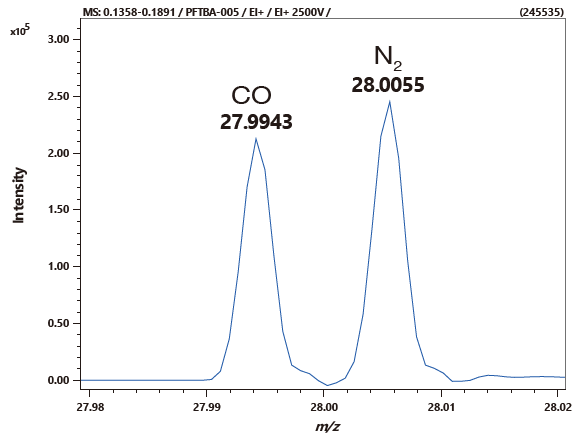
High Mass Accuracy: 1 ppm*1
High mass accuracy makes it possible to determine the elemental compositions for the observed ions. Using the "drift compensation - multiple" mass calibration function, the average mass accuracy (absolute value) for 10 ions observed from

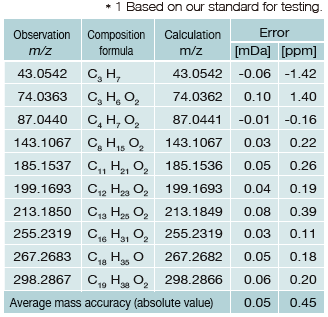
New Qualitative Analysis Capabilities offered by a Variety of Soft Ionizations
- AccuTOF™ GC-Alpha provides multiple ionization methods
Soft ionization - a powerful tool for qualitative analysis
EI, the most widely used ionization technique in GC-MS, is superior in sensitivity and reproducibility and is supported by a variety of library searchable databases.
For any scientist using GC-MS in search of further information, what is ultimately important is molecular ion detection. EI, which uses a high ionization energy of 70 eV, generates numerous fragment ions, from which structural information is acquired. However, EI often fails to show strong molecular ion signals. Consequently, qualitative analysis results may be incorrect if they solely rely on database searches.
Thus, it is critical in GC-MS analysis to enhance the accuracy of qualitative analysis by using various soft ionization techniques in addition to EI. Chemical ionization (CI), photoionization (PI), and field ionization (FI) are all optionally available on the AccuTOF™ GC-Alpha. With the accurate mass measurement capability for all ionization techniques, elemental composition of the analyte can be reliably determined.

Instrument Detection Limit: IDL=18.7 fg
FI and FD ~ Ideal Soft Ionization Techniques for Molecular Weight Determination
FI and FD are extremely soft ionization techniques that provide lower internal energy to the analytes than EI and even CI, thus producing clear molecular ions. As a result, FI and FD are ideal for molecular weight determination.FI (Field Ionization)
- The sample is introduced to the ion source through GC or a standard sample inlet system.
- Unlike CI, FI uses no reagent gas; no need to choose a reagent gas appropriate for the analyte.
FD (Field Desorption)
- The sample is applied onto the emitter and directly introduced into the system.
- Suitable for analysis of thermally labile compounds
- Ideal for samples soluble in nonpolar solvents.
- Analyzes powder samples dispersible in solvents.
- Analyzes low- to mid-polar metal complexes.
- Analyzes high molecular weight samples not supported in GC-MS, such as polymers.

FI and FD ~ EI/FI/FD Combination Ion Source (optional)
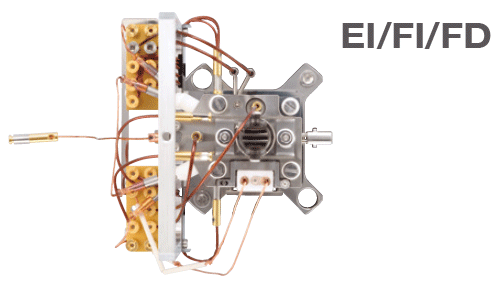 A single ion source that supports both EI (hard ionization) and FI/FD (soft ionization) techniques.
A single ion source that supports both EI (hard ionization) and FI/FD (soft ionization) techniques.
Switching between EI and FI/FD is simple and quick.Features
- No need to replace the ion source
- No need to break the vacuum
- No need for reagent gases
The following analyses are possible by using this combination ion source with GC:
- GC/EI for qualitative analysis through library search
- GC/FI for molecular weight determination
- Accurate mass measurement

PI is an ionization method that uses photons from a vacuum ultraviolet (VUV) lamp for ionization. The AccuTOF™ GC-Alpha has an optionally available combination ion source that offers both EI (hard ionization) and PI (soft ionization). This source makes it possible to switch between EI and PI by simply turning on/off the EI filament as well as the PI lamp.

 PI is particularly useful for the analysis of aromatic compounds in complex mixtures. These compounds produce high intensity peaks with PI because they strongly absorb UV light.
PI is particularly useful for the analysis of aromatic compounds in complex mixtures. These compounds produce high intensity peaks with PI because they strongly absorb UV light.∎ Key Technology 2
A new workflow has been devised to identify unknown compounds by GC-MS. In this workflow, the data analysis is performed by integrating the data obtained by hard ionization (EI) and the data obtained by soft ionization (FI, PI, CI) in order to identify the analytes present in a sample.
Since its introduction in 2018, the msFineAnalysis software for the AccuTOF™ GC series has been well received as an innovative software solution for the automatic qualitative analysis of unknown compounds.
This software makes full use of the high-quality data obtained by the AccuTOF™ GC-Alpha, thus providing a new approach to qualitative analysis for identification of unknown compounds.Evolution into msFineAnalysis AI
msFineAnalysis AI offers a new structure analysis tool for unknowns. The new "integrated analysis" combines GC/EI high resolution data, GC/soft ionization high resolution data, and "structure analysis" using two AIs (Main AI, Support AI). These advanced AI technologies allow msFineAnalysis AI to provide a unique automatic structure analysis capability that was not previously available for GC-MS qualitative analysis.Features of msFineAnalysis AI
- Combines EI/SI data for automatic qualitative analysis
- Structural analysis using two AIs
- Chromatographic peak deconvolution
- Group analysis for extracting compounds with common substructures
- Differential analysis for directly comparing 2 samples
- Also supports the analysis of EI data alone
msFineAnalysis provides quick and efficient data analysis so that the user can spend less time analyzing data and more time on research and creativity!AccuTOF™ GC-Alpha with Direct MS
Direct MS mode is useful for the analysis of high-boiling-point and high-mass compounds that are not amenable for GC.
TOFMS with inherent wide mass range is well-matched with direct MS mode.
Compounds that are measured by GC normally have molecular weights below 500 Da so it is not common to target compounds with molecular weights exceeding 1000 Da by using GC-MS. However, in direct MS mode (no GC is used), high-boiling-point, high-molecular-weight, and nonvolatile compounds can be targeted for measurement, as the sample is directly introduced into the ion source. The mass range of the AccuTOF™ GC-Alpha is m/z 6,000 or higher. Since compounds can be detected over a wider mass range than conventional GC-MS, the system is well suited for measurements in direct MS mode.
Three Direct MS Probes To Choose From

DEP (Direct Exposure Probe) - Sample dissolved or dispersed in solvent is applied to the filament at the tip.
- Suitable for high boiling point and/or thermally labile compounds
- Compatible with EI and CI
DIP (Direct Insertion Probe) - Solid sample can be introduced in the glass sample tube.
- Suitable for high boiling point and/or insoluble compounds
- Compatible with EI and CI


FDP (Field Desorption Probe)- Sample dissolved or dispersed in solvent is applied to the carbon emitter at the tip.
- Suitable for high boiling point, high molecular weight, and/or thermally labile compounds
- Suitable for low- to mid-polar metal complexes
- Used for FD soft ionization
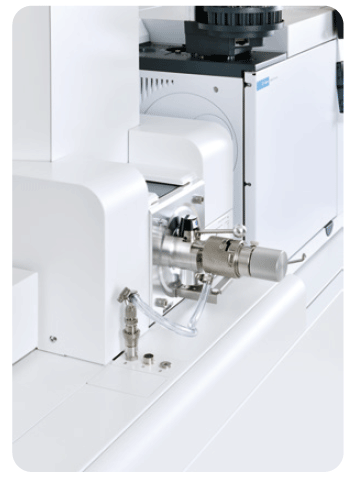
Polymer analysis by FD and Kendrick Mass Defect (KMD) Analysis
FD is an ionization method in which the analyte molecules applied to the emitter are desorbed and ionized by a high electric field. The electric current running through the emitter is gradually increased during the measurement to heat the analyte to assist desorption/ionization. Since the optimum emitter current for ionization depends on the analyte, components can desorb at different times. Separation of components in a mixture is possible, and mass spectra for a specific class of compounds can be extracted. Furthermore, even when compounds are not separated in time during desorption/ionization, each other, target components can still be clearly separated by creating KMD plots.
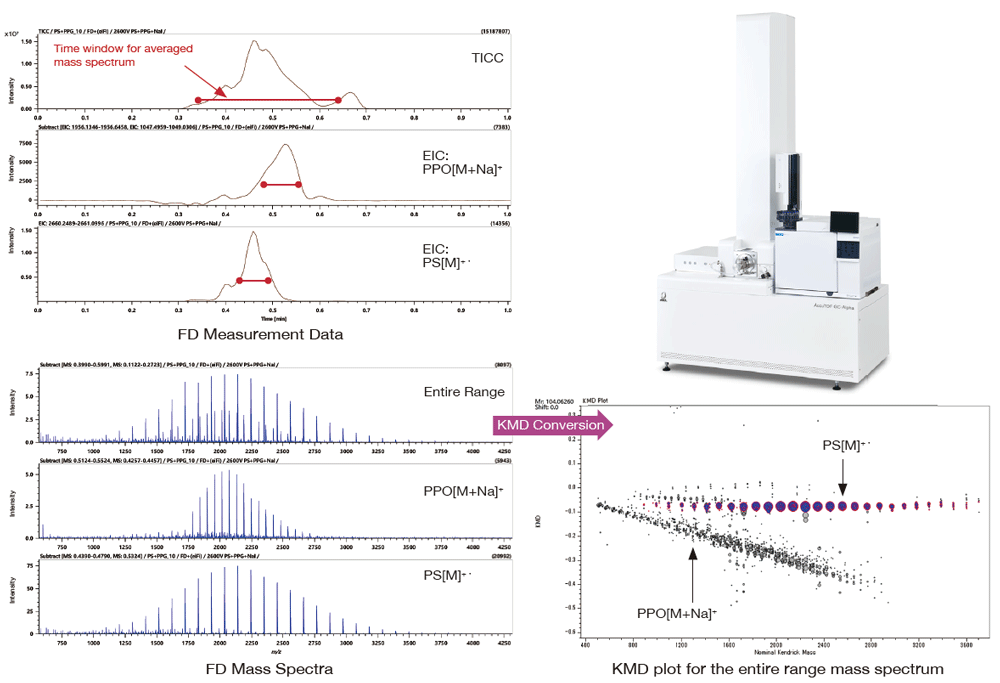
-
Items Specification Ion Source Electron Ionization Analyzer Reflectron Time-of-Flight Mass Spectrometer Detector Dual Micro Channel Plate Data Acquisition System Continuous Averager Gas Chromatograph Agilent 8890 Data System Included Major Options EI/FI/FD combination ion source
EI/PI combination ion source
CI ion source
FD/FI ion source
DIP
DEPSpeed Data Acquisition 50 Hz Mass Range ~m/z 6,000 Instrument Detection Limit IDL=18.7 fg Dynamic Range 4 orders High Mass Accuracy 1 ppm Mass Resolving Power 30,000 -
- Qualitative and quantitative analysis of unknown substances
- Polymer materials, polymer analysis (monomers, additives, oligomers)
- Competitive product analysis
- Qualification of unregistered chemical substances
- Quality management, abnormal product comparison
- GCXGC application, biomarker application
- FAST GC application
- Food inspection, oil analysis
- Petrochemical industry
- Organic synthesis
- Environmental analysis
- Metabolite analysis
- Organometallic analysis
- Flavor analysis








